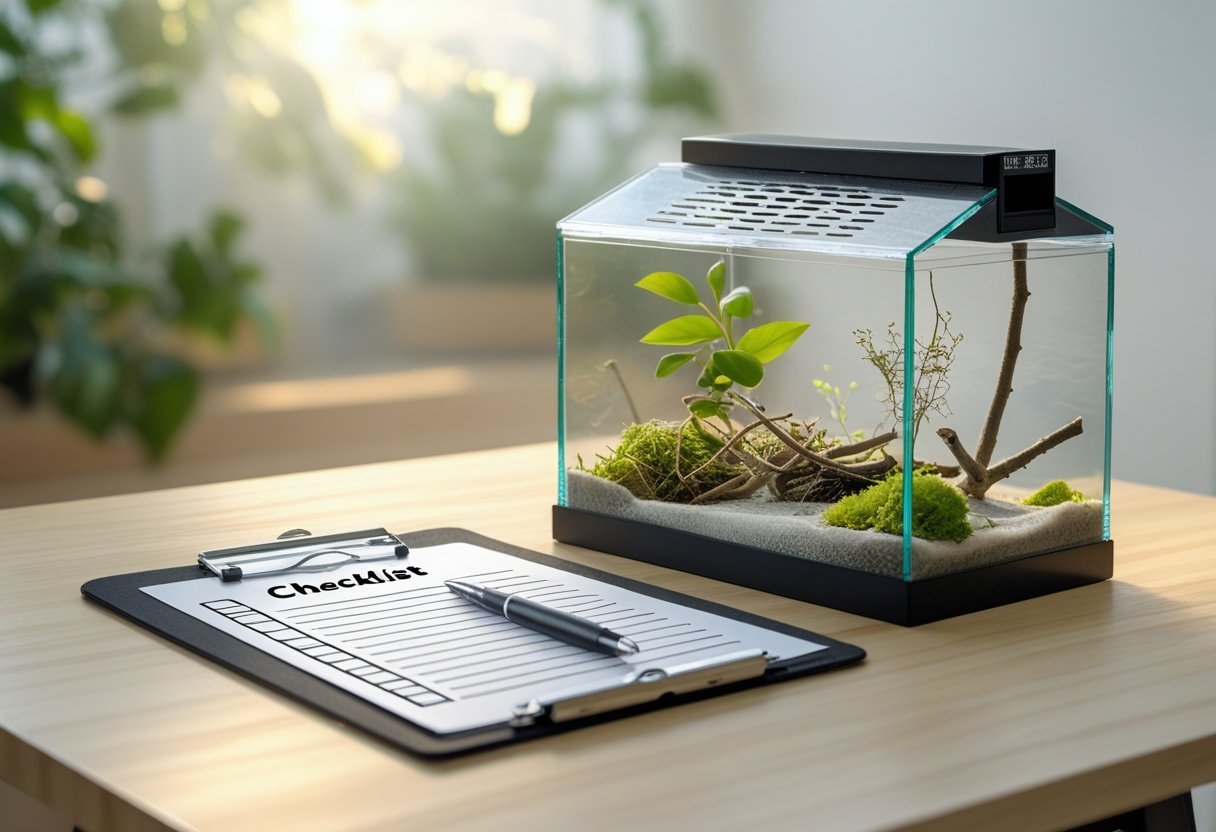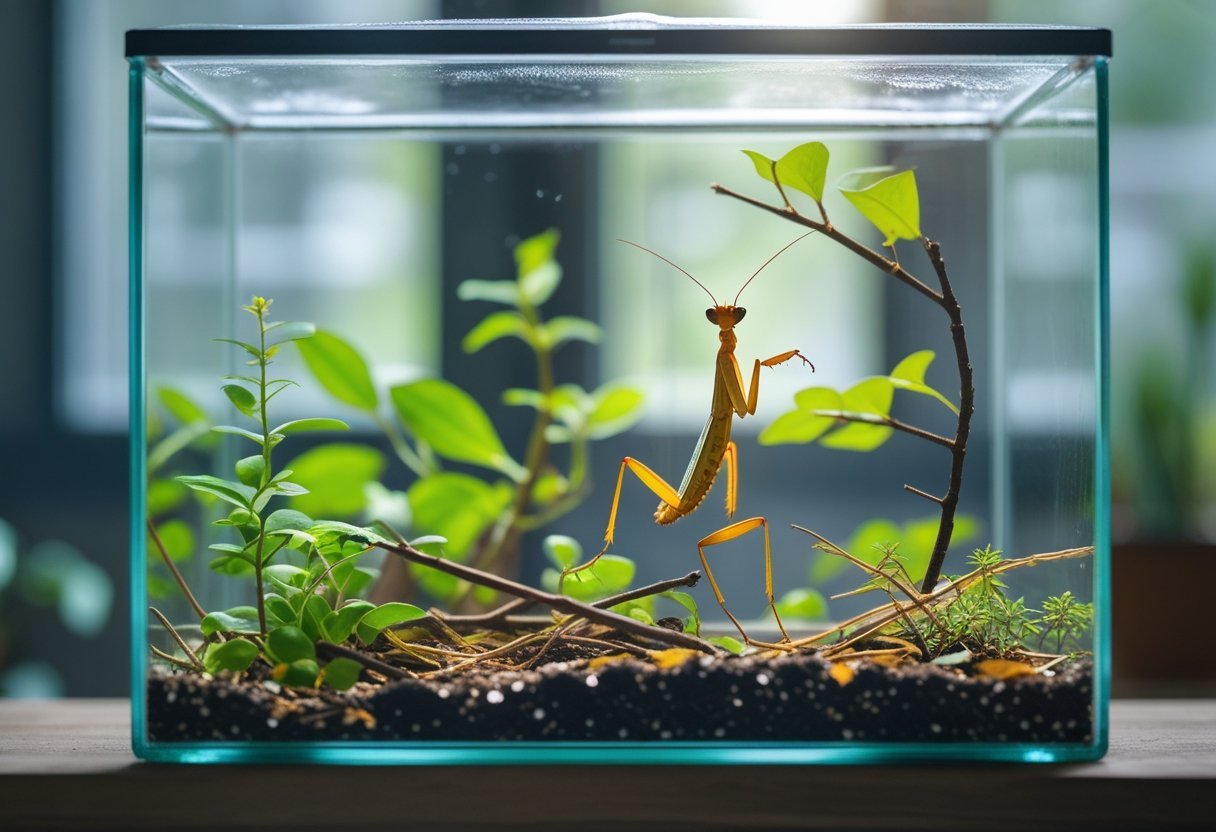Setting up a mantis enclosure requires attention to detail and the right equipment to create a safe, healthy environment. A complete mantis enclosure checklist ensures nothing important is missed, helping mantises thrive from the start. Readers looking for straightforward, reliable guidance will benefit from an organized list tailored for mantis care.

Proper ventilation, secure lids, and suitable climbing surfaces are just a few essentials to consider. By following a focused checklist, enthusiasts can avoid common mistakes and provide for all the needs of their mantis.
Choosing the Ideal Mantis Enclosure

Selecting a mantis enclosure requires careful consideration of size, material, and airflow. The right choice helps ensure proper growth, comfort, and health for any mantis species.
Determining Proper Enclosure Size
A mantis should have an enclosure at least three times its body length in height and twice its length in width. Height is especially critical since mantises hang from the top to molt. For example, an adult Chinese mantis (approximately 4 inches long) needs at least a 12-inch tall enclosure and an 8-inch wide enclosure.
Using an enclosure that is too small can restrict natural behavior and may cause molting issues. If the enclosure is too large, it may make hunting difficult for smaller or juvenile mantids.
Quick reference table:
| Mantis Size | Minimum Height | Minimum Width |
|---|---|---|
| Nymph | 4-6 inches | 3-4 inches |
| Juvenile | 8-10 inches | 6-8 inches |
| Adult | 12+ inches | 8-10 inches |
Keep in mind that some species—like orchid or ghost mantises—prefer more vertical space and sparsely decorated mantis tanks.
Material Options: Glass, Plastic, and Mesh
Glass terrariums provide clarity and durability. They are escape-proof and visually appealing but can trap humidity, which may lead to mold if not properly ventilated. Glass also tends to be heavier and more expensive.
Plastic containers are lightweight, affordable, and easy to modify with custom ventilation holes. Many breeders use plastic jars or food containers for single mantises or small groups. These are practical but may scratch or cloud over time.
Mesh enclosures offer excellent airflow, reducing risks of condensation and mold. However, mesh can be hard for some mantids to climb, and very small nymphs might escape through larger mesh holes. For safety, use fine mesh or netting for small mantids.
Ventilation Needs and Solutions
Proper airflow prevents excess humidity and mold in a mantis habitat. All mantis enclosures—glass, plastic, or mesh—require well-designed ventilation for healthy mantid development.
Glass terrariums and plastic containers benefit from securely fitted ventilation holes or panels on at least two sides. Covering holes with stainless steel mesh ensures durability and keeps mantises in. For plastic lids, punching several small holes (1–2 mm each) can be effective for nymphs and adults.
Mesh mantis tanks provide strong ventilation but also cause moisture to escape quickly. Monitor humidity levels closely, especially for species needing higher humidity. Use a hygrometer to track changes, and consider partial covers to regulate airflow when needed.
Essential Setup Checklist

A mantis enclosure should meet basic needs for comfort, health, and activity. Prioritizing appropriate substrate, ample hiding spots, and stable environmental conditions can support a healthy praying mantis habitat.
Substrate Selection and Maintenance Tips
Selecting the correct substrate is important for moisture retention, cleanliness, and minimizing mold. Common options include coconut fiber, peat moss, and paper towels. Most keepers prefer coconut fiber because it holds humidity well and is easy to spot clean.
The substrate depth should allow for some burrowing during molting but not restrict movement—1–2 inches is usually sufficient for most species. Replace the substrate entirely every 2–4 weeks to reduce bacteria and fungus buildup. Remove uneaten food and visible waste promptly.
Regularly check for signs of mites or mold. If the enclosure develops a sour smell, change the substrate immediately. In DIY mantis enclosures, lining the bottom with mesh above the substrate can improve drainage.
Providing Hiding Spots and Decor
Hiding spots reduce stress for mantises and help mimic their natural environment. Excellent options include pieces of cork bark, twisted twigs, silk or live plants, and dried leaves. These provide shelter and climbing surfaces essential for molting.
Arrange decor to allow vertical movement. Praying mantises often hang upside-down when shedding; ensure there is enough space and at least one sturdy branch that reaches from the substrate to the enclosure top.
Avoid overcrowding the enclosure with decor, which can trap moisture and make cleaning hard. Artificial plants may be used for easy maintenance, but live moss or plants can assist with humidity levels and create a more natural feel.
Humidity Control and Heat Sources
Praying mantis species vary widely in their humidity and temperature preferences. Tropical species thrive at 60–80% humidity, while desert species require much less. Use a digital hygrometer for accurate readings. Mist the sides of the enclosure lightly, never soaking the substrate, and always allow for some airflow to prevent mold.
Daytime temperatures between 72–80°F suit many species. In cooler conditions, a low-wattage heat mat can be attached to the outside of the enclosure for gentle warmth. Never place heat mats underneath, as this can overheat the substrate. Always monitor both temperature and humidity to adjust as needed and maintain a consistent microclimate inside the enclosure.
Species-Specific Enclosure Considerations

Each mantis species has unique environmental and spatial requirements. Proper enclosures help maintain health, prevent stress, and support natural behaviors for each type of praying mantis.
Orchid Mantis Habitat Requirements
Orchid mantises (Hymenopus coronatus) do best in enclosures that highlight vertical space. They prefer to climb, so a tall enclosure with smooth, escape-proof walls and several sturdy branches or live plants is recommended.
Humidity is key for this species—keep it at 60–80% by misting daily. Maintain temperatures between 24–30°C (75–86°F) using a gentle heat source. Good airflow is critical; use a fine mesh lid but avoid drafty locations.
These mantises require gentle lighting for both warmth and to simulate their natural environment. Avoid direct sunlight. Substrate options like coconut fiber or paper towel help retain moisture and provide a safe footing for molts.
Ghost Mantis Care Needs
Ghost mantises (Phyllocrania paradoxa) prefer a more arid setup than some species. Keep humidity around 50–60%, misting lightly every few days. Temperatures should be kept between 23–28°C (73–82°F).
Provide a range of vertical and horizontal sticks, twigs, and dried leaves for climbing and camouflage. Ghost mantises thrive in enclosures at least three times their body length in height and width, which helps them molt easily and corners less frequently trap them.
Lighting: Use ambient room light, as bright lighting is unnecessary and may stress them. Ensure moderate ventilation to prevent mold growth. Soil-based substrates, such as a mix of peat and sand, create a more natural look for this species.
Dead Leaf Mantis Housing Tips
Dead leaf mantises (Deroplatys dessicata) require an enclosure set up to mimic a leaf-littered forest floor. Use a mix of dry leaves, sticks, and bark for decor, as this helps support their camouflage and reduces stress.
Humidity should be maintained at 60–70%, with daily misting preferred. Temperatures should stay between 24–28°C (75–82°F) with gentle heating. These mantises can be startled easily, so avoid loud environments or sudden movements near the enclosure.
Provide a secure lid with adequate airflow. Enclosure size should be roughly three times the adult mantis’s height and allow room for molting. A shallow water dish may be included to help maintain humidity, but ensure the mantis can’t fall in and drown.
Frequently Asked Questions

Praying mantis care involves providing the right enclosure size, setup, and accessories. Species like giant Asian mantises have specific needs for lifespan and care that keepers should know.
What is the appropriate size for a praying mantis enclosure?
A praying mantis enclosure should be at least three times the mantis’s body length in height and twice its length in width and depth. This allows space for molting and movement. For example, an adult mantis measuring 4 inches requires an enclosure at least 12 inches tall and 8 inches wide.
How should a praying mantis enclosure be set up for optimal health?
The enclosure should provide vertical space, plenty of ventilation, and safe surfaces for climbing and molting. Maintain humidity between 50–70% and keep temperature between 75–85°F, depending on species. Add non-toxic twigs or mesh for molting and easy movement.
What are some creative enclosure ideas suitable for a praying mantis?
Some keepers use converted fish tanks, acrylic cubes, or custom mesh cages. Large glass jars with mesh lids also work, as long as they provide good air flow. Decorations can include artificial plants, natural bark, or clean driftwood for climbing.
What items should be included in a praying mantis enclosure kit?
A basic kit should include a securely closing enclosure, substrate like coconut fiber or paper towels, a water spray bottle, and climbing branches. Mesh or netting at the top helps with ventilation and molting. Tweezers and small feeding dishes are also helpful.
How long do giant Asian mantises typically live in captivity?
Giant Asian mantises (Hierodula membranacea) usually live 10–14 months in captivity. Females sometimes live slightly longer than males. Proper diet and consistent conditions support their full lifespan.
What are the essential care requirements for a giant Asian mantis?
Giant Asian mantises need a vertical enclosure, stable humidity, and daily misting. They require live food such as crickets or flies and regular cleaning of their environment. Avoid handling them too often, as this can cause stress.